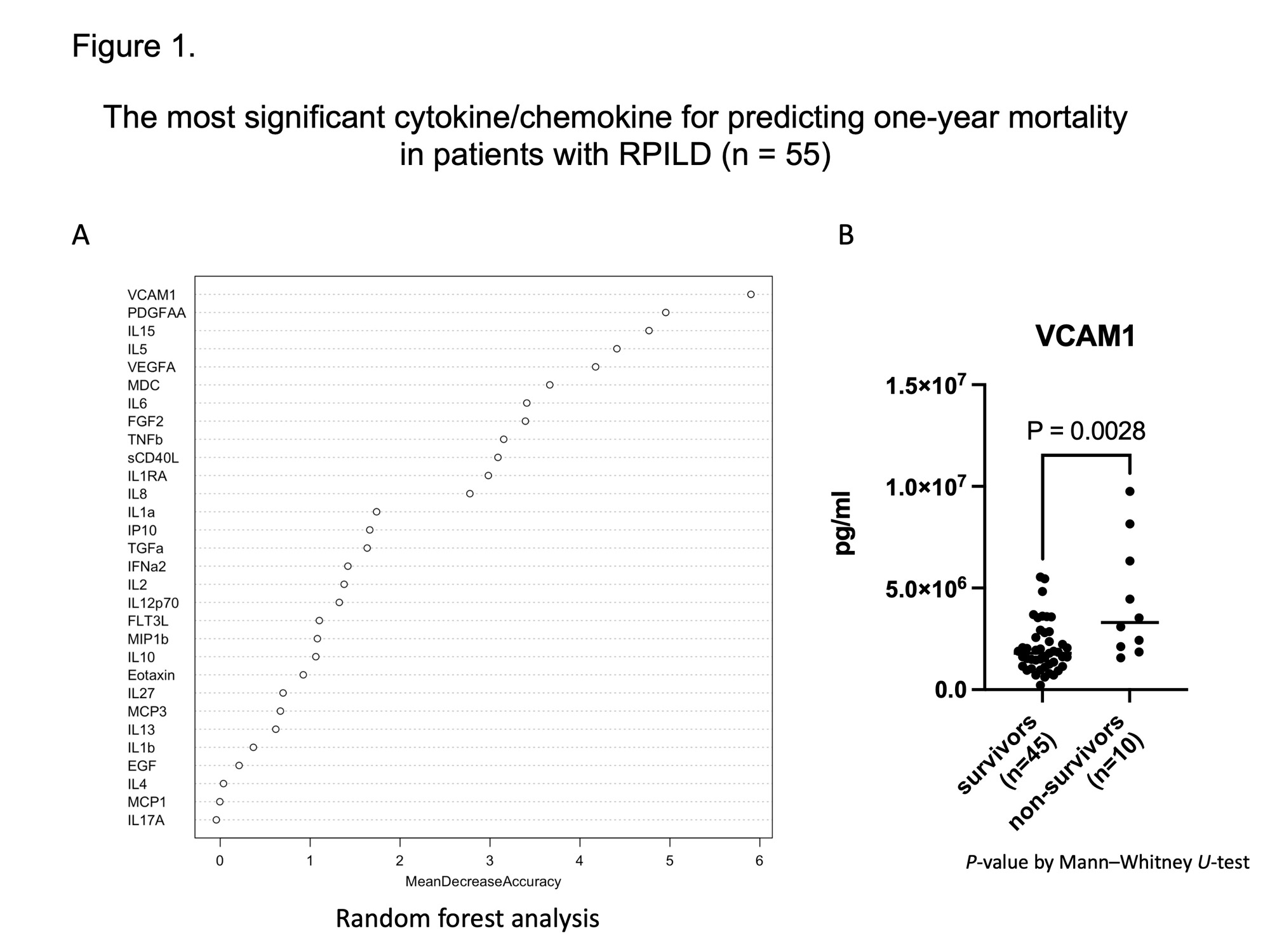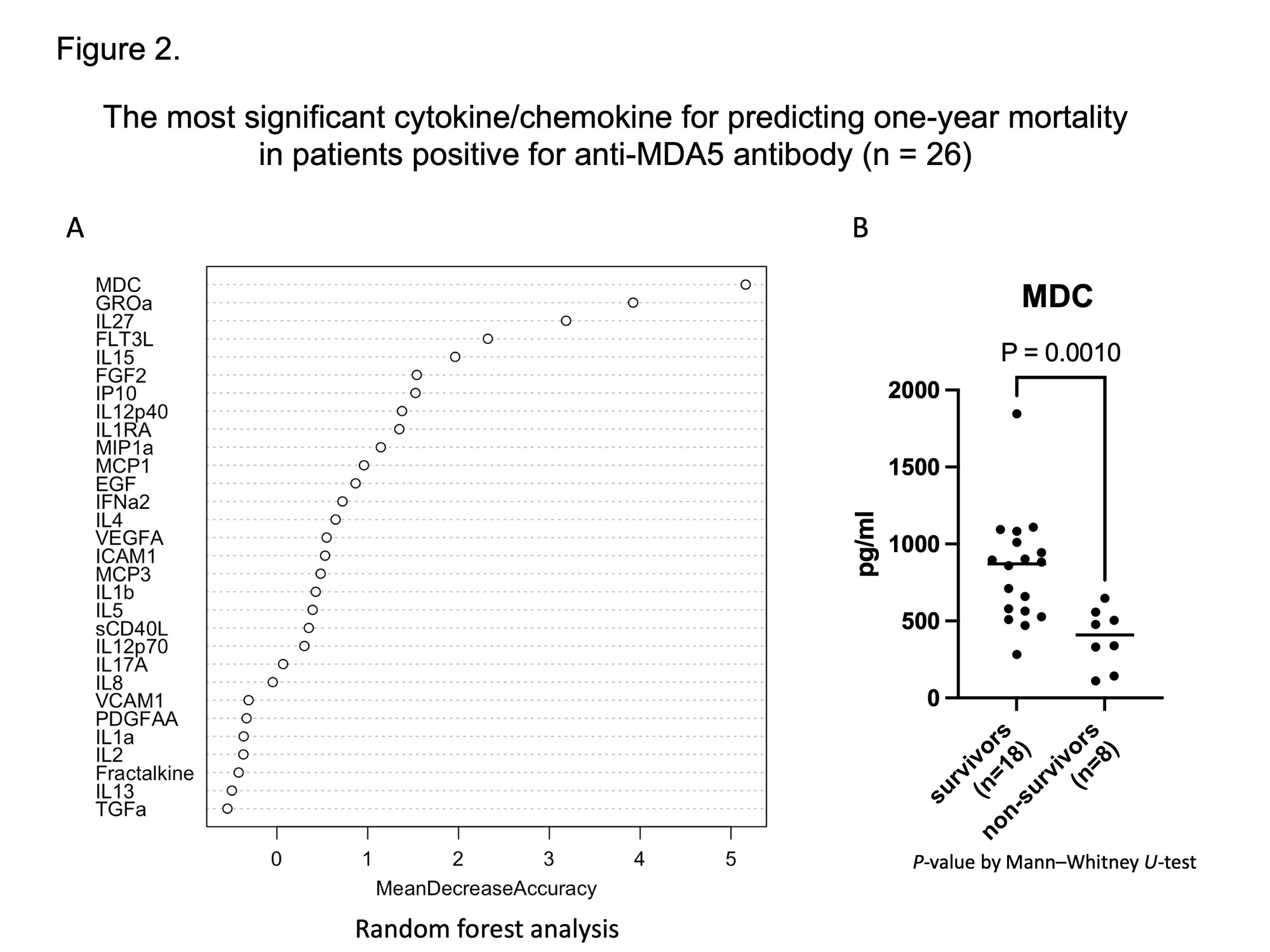Session Information
Date: Monday, November 13, 2023
Title: (1155–1182) Muscle Biology, Myositis & Myopathies – Basic & Clinical Science Poster II
Session Type: Poster Session B
Session Time: 9:00AM-11:00AM
Background/Purpose: Idiopathic inflammatory myopathy (IIM) is a chronic inflammatory disorder involved in skeletal muscles. Interstitial lung disease (ILD) as an organ lesion is a common complication of IIM and may develop into rapidly progressive interstitial lung disease (RPILD), which can be life-threatening. Several myositis-specific antibodies, such as anti-melanoma differentiation-associated gene 5 (MDA5) and anti-aminoacyl-tRNA synthetase (ARS) antibodies, have been associated with developing ILD, which are associated with different prognoses. In addition, patients with IIM-associated ILD are characterized by several radiologic patterns. However, radiological patterns and prognostic biomarkers of IIM-associated ILDs remain obscure, especially in patients with the same antibody positivity. This study aimed to identify the radiological features and specific biomarkers for predicting the short-term prognosis of IIM-associated ILD.
Methods: We enrolled 116 patients with IIM-associated ILD, in either RPILD (n = 55) or non-RPILD (n = 61), who had visited the Department of Immunology and Rheumatology and the Department of Respiratory Medicine at Nagasaki University Hospital between February 2007 and July 2020. We retrospectively obtained the patient’s demographics and clinical characteristics using medical records. The high-resolution CT (HRCT) patterns of ILD, which included diffuse alveolar damage (DAD), nonspecific interstitial pneumonia (NSIP), organizing pneumonia (OP), NSIP with OP, and usual interstitial pneumonia (UIP) pattern, were classified by the experienced pulmonologist. Serum levels of 43 cytokines/chemokines were measured by a multi-suspension cytokine array. These serum variables were ranked by their importance by a multivariate classification algorithm termed random forest analysis.
Results: The one-year mortality rate of patients with RPILD was higher than that with non-RPILD. Within the RPILD group, the HRCT patterns were categorized as follows: NSIP (45.5%), NSIP with OP (25.5%), OP (18.2%), DAD (7.2%), and other (3.6%) patterns. We found the most important cytokine/chemokine for predicting one-year mortality in the RPILD patients was vascular cell adhesion molecule-1 (VCAM-1) using random forest analysis (Fig. 1A). The levels of VCAM-1 were significantly higher in the RPILD groups with survivors than those with non-survivors (Fig. 1B).Among the patients with anti-MDA5 positive ILD, the HRCT patterns were classified as NSIP (46.2%), NSIP with OP (38.5%), OP (11.5%), and DAD (3.8%) patterns. Our random forest analysis revealed macrophage-derived chemokine (MDC), also known as CCL22, was the most significant cytokine/chemokine for predicting one-year mortality in the patients with positive for anti-MDA5 antibody (Fig. 2A). The MDC levels were significantly lower in the patients with survivors than in those with non-survivors (Fig. 2B). In addition, MDC was also the most significant cytokine to predict death within one year in the patients with anti-MDA5 positive RPILD.
Conclusion: This study identified a unique set of serum biomarkers that could predict the short-term prognosis of IIM-associated ILD and characteristic radiological features for each phenotype.
To cite this abstract in AMA style:
Shimizu T, Matsuo H, Koga T, Sakamoto N, Mukae H, Kawakami A. Prognostic Biomarkers and Radiological Features of Idiopathic Inflammatory Myopathy Associated Interstitial Lung Disease [abstract]. Arthritis Rheumatol. 2023; 75 (suppl 9). https://acrabstracts.org/abstract/prognostic-biomarkers-and-radiological-features-of-idiopathic-inflammatory-myopathy-associated-interstitial-lung-disease/. Accessed .« Back to ACR Convergence 2023
ACR Meeting Abstracts - https://acrabstracts.org/abstract/prognostic-biomarkers-and-radiological-features-of-idiopathic-inflammatory-myopathy-associated-interstitial-lung-disease/


